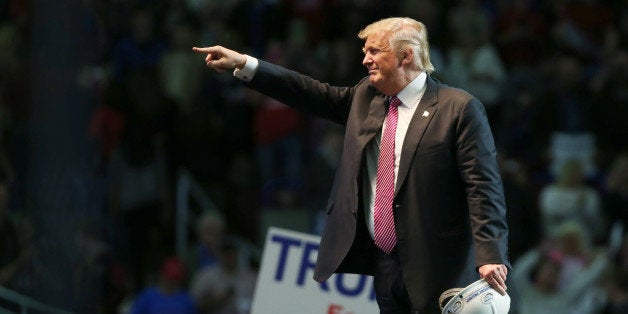
As the Indiana election results rolled in last Tuesday night, a friend from London texted me: "Is there a Plan B? And is anywhere far enough away?" To which I replied, "Plan B is to beat him. You can run, but you can't hide."
But the Indiana primary, pivoting as it did on trade, signaled something else: the elaborate faith in a set of invisible hands that underpinned much of modern conservatism, has lost its grip on a huge swathe of the electorate.
Post WWII conservatism -- the brand forged by intellectuals like William Buckley and politicians like Barry Goldwater -- wove three strands together. American greatness was to be demonstrated by defeating communism. Conservatism would revive rugged individualism by rolling back the New Deal. Third, it pledged to secure the traditional, patriarchal family from the assaults of decadent modernism. Each of these strands was a reaction, against the form modernity was taking.
Conservatives recognized that this was a conflicted coalition. The rural and small town voters who worried about family values had been among the principal beneficiaries of the New Deal. The business Republicans who hated high taxes were also the agents of cultural modernism. And the demands of unity and national mobilization against Communism fitted poorly with state enforcement of traditional values and the shredded safety net that economic conservatives sought.
Conservative thinkers eventually forged their coalition by putting Adam Smith's idea of the invisible hand on steroids. Cultural traditionalists were persuaded that since American society was fundamentally conservative, shrinking the government would prevent the real threat, modernist social engineering by bureaucrats. (Just take democracy's hand off the wheel and all will be well) Suburban business Republicans were assured that they would, of course, remain the senior partners. Traditionalists might curb the social freedoms of the masses, but elites would retain their reproductive rights. (They'll never touch you.) And working class Republicans were indoctrinated that deregulation and liberalized global trade would protect their incomes without the New Deal. American global hegemony and dominance would take the place of unions. (Smith's invisible hand painted red, white and blue.)
Once this conservative agenda began to be implemented after Ronald Reagan's election, the contradictions started to unravel the coalition. One pillar of the "Fusion" conservatism, the defeat of communism, came to pass. But the fall of the Berlin Wall reopened the question of the historic conservative preference for isolationism. Republican presidents never delivered on the social agenda. As the cosmopolitan shift in the nation's demography and culture that a globalized economy made inevitable felt to social traditionalists like a betrayal -- driving the first wedge into the right-wing coalition. But conservatism still had some powerful glues -- hierarchical instincts within its base, access to enormous financial resources, and the weakening of the liberal imagination. It might have avoided this year's train wreck if Adam Smith's original invisible hand had worked -- if America had been able, simply by deregulating and globalizing, to maintain middle class economics while letting elites gobble up more and more of the pie.
It couldn't. And that is the hidden truth that Donald Trump (and Bernie Sanders) have now injected into our political system, with such vehemence that it seems unlikely to go away. Without conscious government intervention, America cannot sustain middle class incomes in a globalizing, technologically galloping world.
This flies in the face of the existing, bipartisan establishment consensus -- markets, not governments, drive wages. Donald Trump's border wall was originally proposed in 2006 by moderate Washington Post columnist Robert Samuelson, to cure an oversupply of low skilled labor and raise wages -- Samuelson preferred to build a wall than raise and broaden the minimum wage. Then House Speaker Richard Gephardt's proposal to tie NAFTA to an agreement with Mexico to permit its wages to rise with productivity were rejected by the Clinton Administration as well as Republicans in 1993.
Otherwise liberal voices like The New York Times shamelessly pled for a combination of trade, labor and immigration policies callously designed to weaken labor markets -- and then lamented the stagnant wages that followed.
The leadership of both parties has thus been, at best, ambivalent about whether maintaining the New Deal economic order, with policy driven flattening of historic economic hierarchies, was a priority, or even desirable. About a month ago, I watched a brilliant leader of the American establishment lament the nation's turn against social inclusion, multilateral globalism and free trade. His gut told him that in a Clinton-Trump race, Clinton won, but only because Trump was weak, not because Americans still bought the invisible hand economics of free trade, liberal immigration and weak safety nets.
Asked by a listener what the Establishment might learn from this near disaster, he looked befuddled. What, he mused, was there to learn? Surely not to reject tolerance, global cooperation or trade? The idea of a major revamping of public policy to raise wages simply didn't strike him as an option.
But the Indiana primary victories of Donald Trump and Bernie Sanders signal the second death of invisible hand politics in the U.S (the Depression was the first). The public no longer accepts the erosion of the middle class. We need immigrants. We need the benefits of broadly liberal global trade. But we can only have them if we also assure, through wage, tax, and trade policy, that higher wages for average Americans -- not maximum opportunity for the fortunate few -- becomes our highest economic priority.
The establishment will argue back that in a globalized world with rapid technology changes, average Americans can't expect to have globally better than average wages. Certainly none of the candidates have offered a convincing strategy for getting there. But Trump and Sanders have put that unanswered challenge solidly at the heart of our politics.